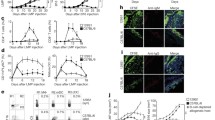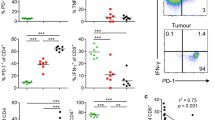Summary
The mechanisms of rejection of secondary tumours were studied in concomitant immunity using transplants of standard-size solid SL2 tumours in syngeneic DBA/2 mice. In such a system primary tumour implants are not rejected, in contrast to secondary tumour implants. The second tumour was mainly rejected 2–4 days after implantation. Both primary tumour and secondary tumour implants (which are rejected) contained hardly any lymphocyte infiltrate, whereas, 2–4 days after implantation they contained 40%–50% macrophages, which were cytotoxic in vitro. Transfer (s.c.) of these tumours to naive mice showed that cellular infiltrates in the secondary implants did not always cause tumour rejection. Serum collected on day 4 after implantation of the secondary tumour was cytotoxic to SL2 tumour cells in vitro, whereas serum from mice with only primary implants was not cytotoxic on day 4 after implantation. Preliminary characterization of this cytotoxic factor showed that it was heat-labile, as cytotoxicity disappeared after 30 min at 56°C, the molecular mass of the factor was higher than 100 kDa, and it was not IgG. We hypothesize that secondary tumours in the DBA/2-SL2 concomitant immunity system are rejected mainly between 2 and 4 days after implantation as a result of the combined action of cytotoxic serum and the presence of 40%–50% cytotoxic macrophages. The primary tumour is not rejected at 2–4 days after implantation as there is no cytotoxic factor.
Similar content being viewed by others
References
Akporiaye ET, Kudalore MK (1989) Implantation of a gelatinsponge as a model for effector recruitment. Tumour growth inhibition by T-lymphocytes recovered from a site of tumour rejection. Cancer Immunol Immunother 29: 199
Akporiaye ET, Kudalore M, Stevenson AP, Kraemer PM, Stewart CC (1988) Isolation and reactivity of host effectors associated with the manifestation of concomitant tumour immunity. Cancer Res 48: 1153
Chen Y, Anderson AB (1988) Effector mechanism of tumour immunity in murine plasmacytoma. Cancer Res 48: 1398
Den Otter W (1987) Evaluation of knowledge of in vivo tumoricidal effector mechanisms. Res Monogr Immunol 11: 109
Den Otter W, Evans R, Alexander P (1972) Cytotoxicity of murine peritoneal macrophages in tumour allograft immunity. Transplantation 14: 220
De Weger RA, Runhaar EA, Den Otter W (1986) Cytotoxicity by macrophages and monocytes. Methods Enzymol 312: 458
De Weger RA, Wilbrink B, Moberts RMP, Mans D, Oskam R, Den Otter W (1987) Immune reactivity in SL2 lymphoma-bearing mice compared with SL2-immunized mice. Cancer Immunol Immunother 24: 25
Dullens HFJ, Den Otter W (1974) Therapy with allogeneic immune peritoneal cells. Cancer Res 34: 1726
Dullens HFJ, Hilgers J, Spit BJ, De Heer E, De Weger RA, Van Basten CDH, Den Otter W (1982) Staging, growth properties and metastatic behaviour of a transplantable murine T-cell lymphoma. Int J Tissue React 4: 15
Gillespie GY, Hansen CB, Hoskins RG, Russell SW (1977) Inflammatory cells in solid murine neoplasms. IV. Cytolytic T lymphocytes isolated from regressing or progressing Moloney sarcomas. J Immunol 119: 564
Gorelik E (1983) Concomitant tumour immunity and the resistance to a second tumour challenge. Adv Cancer Res 39: 71
Hamaoka T, Fujiwara H (1987) Phenotypically and functionally distinct T-cell subsets in antitumour responses. Immunol Today 8: 267
Li Cy, Lam KW, Yam LT (1973) Esterase in human leucocytes. J Histochem Cytochem 21: 1
Loveless SE, Heppner GH (1983) Tumor-associated macrophages in mouse mammary tumours: I. Differential cytotoxicity of macrophages from metastatic and non-metastatic tumours. J Immunol 131: 2074
McBride WH (1986) Phenotype and functions of intra-tumoral macrophages. Biochim Biophys Acta 865: 27
Plata F, Sordat B (1977) Murine sarcoma virus (MSV)-induced tumours in mice: I. Distribution of MSV-immune cytolytic T lymphocytes in vivo. Int J Cancer 19: 205
Ruggiero RA, Bustuoabad OD, Bonfil RD, Meiss RP, Pasqualini CD (1985) “Concomitant immunity” in murine tumours of non-detectable immunogenicity. Br J Cancer 51: 37
Russell SW (1981) Obtaining mononuclear phagocytes from disaggregated neoplasms. In: Adams DO, Edelson PJ, Koren HS (eds) Methods for studying mononuclear phagocytes. Academic Press, New York, p 103
Russell SW, Gillespie GY, Pace JL (1980) Evidence for mononuclear phagocytes in solid neoplasms and appraisal of their nonspecific cytotoxic capabilities. Contemp Top Immunobiol 10: 143
Ryoyama C, Ryoyama K (1989) Effects of injection routes of growing tumours PSK or OK-432 on antiproliferative activity of mouse serum. Cancer Immunol Immunother 28: 101
Van Loveren H, Den Otter W (1974) Macrophages in solid tumours: I. Immunologically specific effector cells. J Natl Cancer Inst 53: 1057
Yamazaki M, Okutomi T (1989) Augmentation of release of cytotoxin from murine bone marrow and peritoneal macrophages by tumour transplantation. Cancer Res 49: 352
Author information
Authors and Affiliations
Rights and permissions
About this article
Cite this article
Characiejus, D., Dullens, H.F.J. & Den Otter, W. Mechanisms of tumour rejection in the murine DBA/2-SL2 concomitant immunity system. Cancer Immunol Immunother 32, 179–184 (1990). https://doi.org/10.1007/BF01771454
Received:
Accepted:
Issue Date:
DOI: https://doi.org/10.1007/BF01771454




